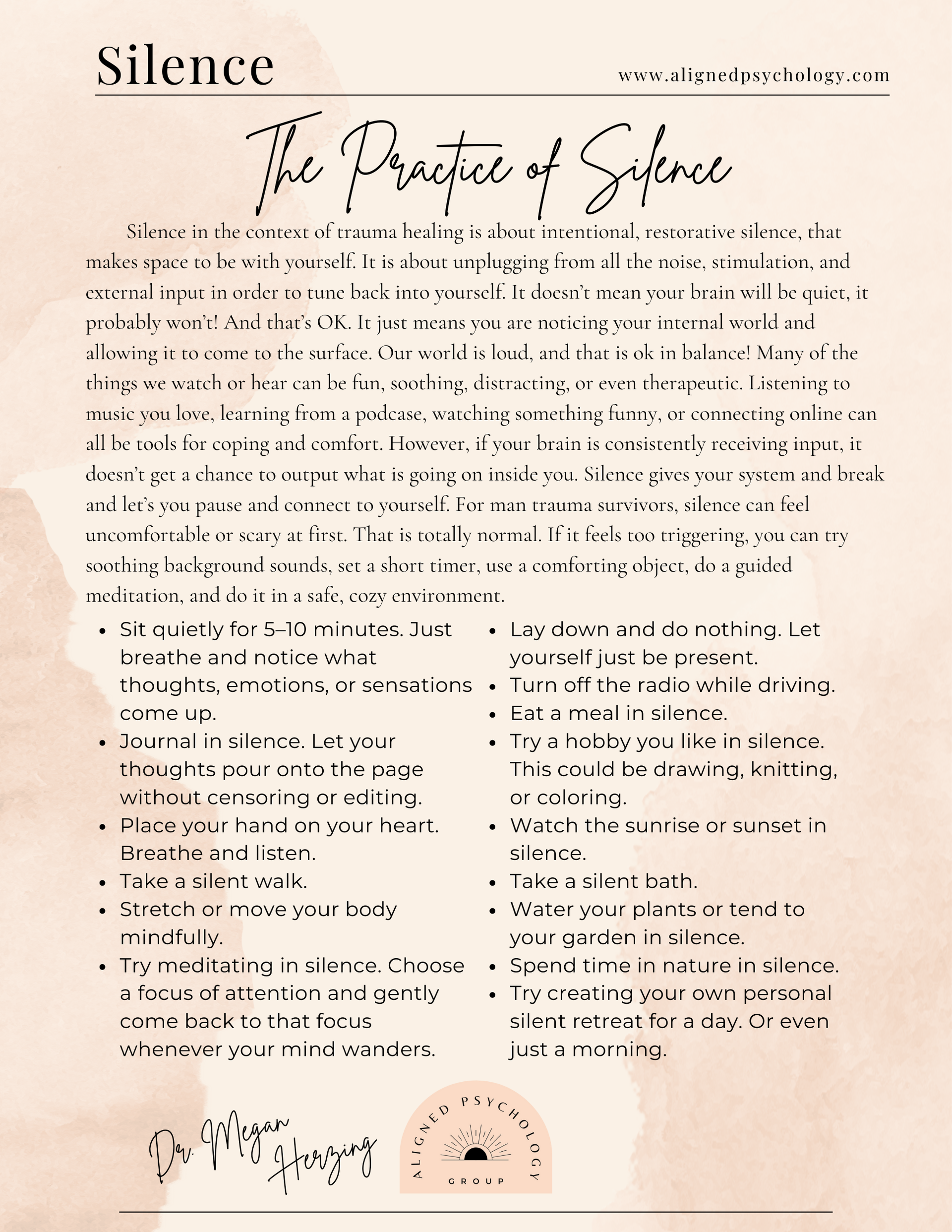Trauma Therapy Homework - Week 17
Week 17: (The Basics)
Silence
Welcome to Week 17 of your trauma therapy homework. If you’ve made it this far, give yourself a moment to pause and appreciate the work you’ve done! Healing isn’t linear, and it definitely isn’t easy—but every time you show up, reflect, or even just think about doing the work, you’re making progress. This week, we’re going to explore something that often gets overlooked yet is deeply powerful: silence.
Let’s start with the basics. When we talk about silence in the context of trauma healing, we’re not talking about punishing quiet or being ignored. We’re talking about intentional, restorative silence—the kind that creates space to simply be. It’s about unplugging from noise, stimulation, and external input so you can tune back in to yourself. Silence in this context is a practice. It doesn’t mean your brain will be quiet (spoiler: it probably won’t be). It doesn’t mean you’ll feel peaceful or calm right away. Silence just means allowing space for whatever is already inside of you to come to the surface.

Our World Is Loud—And That’s Okay (In Balance)
Let’s be real: silence is rare these days. Our lives are filled with a constant stream of sensory input—TikToks, podcasts, playlists, texts, emails, YouTube, Netflix, group chats, work calls... it never stops. And to be clear, none of these things are inherently bad. In fact, many of them are soothing, fun, distracting, and even therapeutic in their own way.
Listening to music you love, watching a funny show, scrolling for inspiration or connection—these can all be tools for coping and comfort. But when every spare second is filled with something, we lose the ability to sit with ourselves. We lose that internal connection that helps us process, reflect, and heal. Think of it like this: if your brain is constantly absorbing input, it doesn’t get the chance to output what’s going on inside. Silence gives your system a break. It’s a pause that lets your thoughts and your feelings be seen.
What Silence Offers Us
So, what actually happens in silence? For many people, especially those navigating trauma, silence can feel uncomfortable or even scary at first. That’s totally normal. It might feel like your mind is racing, or like emotions you’ve been avoiding suddenly show up uninvited. But beneath that initial discomfort is an incredible opportunity: the chance to reconnect with yourself.
Silence allows:
- Space to notice your thoughts instead of reacting to them.
- Time to feel your emotions, even if they’re messy.
- Moments to check in with your body and see what it needs.
- The ability to reflect on patterns, relationships, or triggers.
- A way to reconnect to your internal world after trauma may have made it feel unsafe or chaotic.
And remember, silence isn’t about perfection. It’s about practice. The goal isn’t to sit in perfect stillness with a clear mind. The goal is to just show up for yourself, as you are, and listen.
The Observer Self (a.k.a. Your Core Self)
One of the beautiful things that can happen in silence is noticing your internal world with your observer self—also known in parts work as your Core Self. This is the part of you that witnesses without judgment. It’s the calm, curious, compassionate presence inside you that can sit back and simply notice what’s happening without trying to fix, change, or judge it. Silence creates the space for your Core Self to step forward. You begin to notice that while you have thoughts and emotions, you can observe them. You’re the one noticing. You’re the one holding space. That’s powerful. Try to get into the observer mindset when you are practicing silence. It's ok if this takes practice or if you go in and out of it. That is normal! When you notice you are out of the observing space, just gently bring yourself back to observing and noticing what is coming up.

Ways to Practice Silence
Silence looks different for everyone. What matters most is creating a little space where you’re not absorbing input from the outside world, and instead turning your attention inward. Here are a few ideas to explore:
- Sit quietly for 5–10 minutes. No music, no distractions. Just breathe and notice what thoughts, emotions, or sensations come up.
- Journal in silence. Let your thoughts pour onto the page without censoring or editing. Write like no one will read it (because no one has to).
- Place your hand on your heart. Breathe and listen.
- Take a silent walk. Leave your headphones at home and just notice the rhythm of your steps, your breath, and the world around you.
- Stretch or move your body mindfully. Slow, intentional movement helps you tune into your physical sensations and emotions.
- Meditate. Try meditating in silence. Choose a focus of attention like your breath, a candle flame, or a mantra and gently come back to that focus whenever your mind wanders.
- Lay down and do nothing. Let yourself be. Not productive, not entertained—just present.
- Turn off the radio while driving. Let yourself sit with your thoughts.
- Eat a meal in silence. Pay attention to the food and the experience.
- Try a hobby you like in silence. This could be drawing, knitting, or coloring.
- Watch the sunrise or sunset in silence.
- Take a silent bath.
- Water your plants or tend to your garden in silence.
- Spend time in nature in silence.
- Try creating your own personal silent retreat for a day. Or even just a morning.
If silence feels uncomfortable, start small. Try a few minutes at a time. You don’t have to sit cross-legged on a mountain to benefit from a moment of stillness. It’s about making space for yourself in whatever way feels doable.

Listening to Your Own Thoughts
One of the biggest gifts of silence is that it allows us to hear our own thoughts. That may sound obvious, but think about it: how often do you let your thoughts finish? Not just the surface stuff like “I need to do laundry” or “what should I eat tonight,” but the deeper ones that you tend to push aside?
In silence, we can hear:
- The worries that haven’t been spoken.
- The grief that hasn’t been acknowledged.
- The joy that’s been waiting to be felt.
- The desires you haven’t given yourself permission to name.
When you give your mind space to speak freely, your thoughts reveal what needs attention. Sometimes silence helps you sort things out. Sometimes it just shows you what’s there—and that’s enough.
Silence as a Tool for Healing
Silence isn’t a fix-all, and it’s not about avoiding life. It’s about pausing, creating enough space between you and the noise so you can hear yourself think. It’s about giving your nervous system a break, your thoughts a chance to breathe, and your emotions a safe space to rise and fall. When practiced regularly, silence can become a ritual of reconnection—a way to check in with your internal world before reaching out to the external one. It doesn’t need to be perfect or profound. Just consistent. Just real.
This Week’s Practice
- Choose a daily moment of silence. Even if it’s just 3–5 minutes. Set a timer if that helps, and let yourself be quiet.
- Debrief about what came up. You can do this mentally, or you can journal or write notes. What did you notice? What surprised you?
- Reflect on your relationship with silence. Has it been soothing or uncomfortable? What’s your history with it?
- Optional: Share your experience with someone you trust. Sometimes saying it out loud helps integrate it more deeply.
Remember, this is your journey. There’s no wrong way to engage with silence. You’re allowed to ease into it. You’re allowed to come back to it later. You’re allowed to explore it gently, like dipping a toe into still water.

Disclaimer: If Silence Feels Uncomfortable or Unsafe
For trauma survivors, silence can sometimes feel triggering. If you grew up in chaotic environments, silence may feel eerie or threatening. If your trauma involved isolation or abandonment, quiet may bring up hard memories. That’s okay.
Here are a few gentle tips if silence feels too much:
- Start with guided silence—like a calming voice meditation or a body scan.
- Use soothing background sounds like rain, ocean waves, or white noise instead of complete silence.
- Set a timer for just 2–3 minutes and let that be enough.
- Do it in a safe, cozy environment—wrapped in a blanket, surrounded by comforting things.
- Keep a journal or grounding object nearby if anything comes up that feels big or overwhelming.
You never have to force yourself into silence. It’s an invitation, not a requirement. Go at your own pace.
Final Thoughts
Silence may seem like a small thing in a world that moves fast and talks loud, but it’s actually a radical act of self-connection. It’s a way to return to yourself, to listen inward, and to remember that who you are beneath the noise is enough. Your Core Self is in there, waiting—not to be perfect, but just to be. To listen, to witness, to hold space. This week, I hope you find a few quiet moments. Not to escape life but to more fully meet yourself within it. And when you do, know that you’re doing powerful work—quiet, yes, but so very meaningful. Until next week, be gentle with yourself. You’re doing great.
FREE Downloadable Handouts
Click this LINK for free access to downloadable PDFs from the Trauma Therapy Homework Series. You’ll be directed to my Google Drive folder, where you can explore all the handouts created so far. You can choose between a digital format for easy viewing on your device or a printable version if you prefer a hard copy.
Here is a preview of this week's handout! Click the link above to get your own free pdf copy.


ABOUT THE AUTHOR
Dr. Megan
Megan Herzing PsyD, Licensed Professional Clinical Counselor, specializes in trauma therapy and creating a safe, supportive space for healing. She integrates evidence-based modalities, including EMDR, Internal Family Systems (IFS), somatic therapy, and Emotionally Focused Therapy (EFT), to address the mind-body connection and empower clients on their journey to wellness. With extensive experience treating complex PTSD, anxiety, attachment injuries, and dissociation, she believes in the power of self-compassion and authentic connection to facilitate lasting change. Drawing from her own healing journey, she brings empathy and lived experience to her work, honoring each client’s unique path toward growth and resilience.
Thank you for being part of a community of humans that deeply cares about healing.
We are honored that you stopped by and hope our resources will continue to bring value to your life.
We are accepting new clients in California, and referrals are always appreciated.












